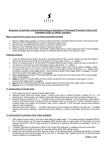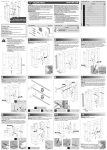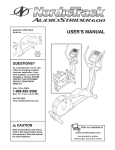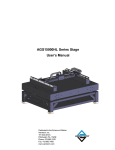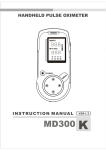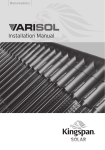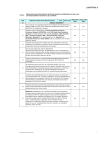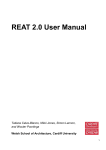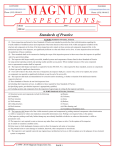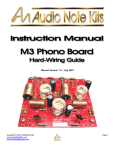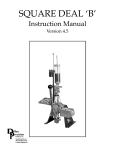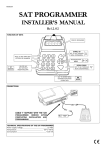Download take control of your world
Transcript
take control of your world INSTALLER’S MANUAL AUTOMATIC GARAGE DOOR OPENER REVISED DATE: March 2004 IND EX 3 1. WHAT’S IN THE BOX A list of contents you will receive with this product and technical specifications 2. WHAT’S NOT IN THE BOX 5 A list of optional accessories available for this product. Please contact your E.T supplier for more information. 3. RECOMMENDED TOOLS 6 A list of tools recommended for the installation of this product 4. IMPORTANT: BEFORE INSTALLING 7 What you need to know before installing this product. P L E A S E E N S U R E T H A T Y O U R E A D A N D U N D E R S T A N D THIS S E C T I O N B E F O R E INSTALLING THE PRODUCT. This section highlights any special warnings and precautions. 5. INSTALLING THE HARDWARE 6. WIRING & SCHEMATICS 17 7. PROGRAMMING & COMMISSIONING 20 8 . MAINTENANCE 23 9 . TROUBLESHOOTING 24 1 0 . WARRANTY 29 11. NOTES 30 Documented serial number and date of purchase 2 9 · 1 x Motorhead - complete · 1 x installer’s m a n u a l · 1 x user’s m a n u a l In sealed bag: · 4 x M6 x 75mm hexagonal bolts · 4 x 6mm washers · 1 x M8 R a w l b o l t · 4 x M8 x 40mm coachscrews · 1 x M8 x 90mm hexagonal bolt · 7 x M8 Nylock nuts · 4 x M8 x 16mm hexagonal bolts · 2 x M8 x 25mm hexagonal bolts · 1 x wall mount bracket · 1 x door bracket · 4 x No.4 3 m m x 1 6 m m c o u n t e r - s u n k s e l f - t a p p ing screws ( p o s s i e - WHAT’S IN THE BOX MOTORHEAD : d r i v e head) · 1 x emergency manual release cord kit · s h o r t s t r i p d o u b l e - s i d e d v e l c r o (for fixing TX to wall for wall console) DRAWBAR: · 1 x d r a w b a r c o m p l e t e (see technical specifications overleaf for more details) · 2.5 lengths perforated angle hanging straps · 1 x link arm · 2 x magnets and holders for chain 3 WHAT’S IN THE BOX TECHNICAL SPECIFICATIONS Motor - 220v AC 50Hz - 2 Amp single-phase - Thermal overload protection - Intermittent duty cycle Drive assembly - Worm reduction gearbox - Sprocket and chain driven Traveling speed: - 8.6 metres/ minute (approx.) Operating temperature: - 0°C – 50°C Control system: - Microprocessor controlled - On-board 2-channel receiver with remote holiday lock-out option. - Revolution counter load sensing. Required front-end spacing above door: - Sectional overhead doors: 50mm above highest point of travel - Trackless one-piece doors (tip-up): 275mm top edge of closed door Drawbar options: - 2m: Standard door with 7 foot hinge - 2.5m: Oversize door with 8 or 9 foot hinge - 3m: Sesco door up to H 2.3 - 3.5m: Sesco door 2.3 - 2.7m 4 1, 2 or 3 button transmitters (remote controls) · Escape lock (to use when no side entrance to garage) · Extendable link arm (to use when motor installation above door not possible. Please ask for advice before attempting to fit these) · Safety infra-red beams or other safety input device · Multi-memory location receiver for individual coding security · Assortment of nuts, bolts, wall plugs, Rawl bolts, coachscrews, WHAT’S NOT IN THE BOX · pop-rivets, dowels, self-drilling screws or chemical fasteners needed for fixing of operator to non-wooden doors and hanging structures. PLEASE CONTACT YOUR E.T. PRODUCT SUPPLIER FOR MORE INFORMATION OR TO ORDER THE ABOVE. 5 RECOMMENDED TOOLS · electric hammer-action drill · 13mm masonry bit · 5mm wood bit · 1 0 m m s p a n n e r / wrench · 2 x 13mm spanners/ wrenches · 2.5mm blade flat screwdriver · PH01 star screwdriver · ha c k s a w · hammer · 6ft/ 2m A-frame self-standing stepladder · tape measure · spirit level In the case of a non-wooden door, always check with the door supplier as to recommended fixings and types of tools needed for the installation of a garge door operator on their doors. 6 OPERATOR, PLEASE BE CERTAIN YOU HAVE READ AND UNDERSTOOD THE FOLLOWING: 1. CHECK THAT THE GARAGE DOOR IS MECHANICALLY SOUND AS PER MANUFACTURERS SPECIFICATIONS. Points to inspect (general to all makes of doors): · Mechanisms must be secure, sound, lubricated. Door hinging and balancing mechanisms must be fastened properly to both door and BEFORE INSTALLING BEFORE ATTEMPTING TO INSTALL A GARAGE DOOR structure. · All nuts and bolts must be tightened according to manufacturers specifications. · Do not attempt to adjust tensioning systems unless duly qualified to do so. · Ensure springs are not over-stretched and are functioning properly. · Test door for ease of operation with no snags throughout d o o r ’ s t r a v e l t o f u l l o p e n i n g t o f u l l c l o s i n g positions. 2 . E N S U R E T H A T A S O L I D F I X I N G P O I N T I S U S E D A B O V E D O O R for securing the front-end bracket. A c o r r e c t l y f a b r i c a t e d b r a c k e t extended f r o m a s o l i d s t r u c t u r e i s t o b e u s e d i n t h e c a s e o f fascias, false panelling, header panels etc. For installations i n b l o c k w a l l s ( c i n d e r b r i c k s ), you s h o u l d u s e a t h r o u g h - b o l t or cross-braced plate. 3. ENSURE THAT THE HANGING BRACKETS USED TO SECURE THE MOTORHEAD are fixed to a structure that can support the weight and load of the garage door operator in operation. (Rhino boarding and ceiling board DO NOT qualify as solid structures). 7 BEFORE INSTALLING 4. INSPECT THE SPINE (TOP EDGE) OF THE DOOR for weaknesses such as cracks or wood-knots. Ensure that the point that the door mount bracket is attached to, will sufficiently support the weight and load of the door when operated. If there is any question to the above, replace or brace the spine (top edge) of the door with stronger material. 5. ENSURE THAT ANY MECHANICAL LOCKS are either removed or securely locked in the UNLOCKED position. 6. ONE CHALLENGER DOOR OPERATOR IS NOT INTENDED TO BE USED TO OPERATE TWO SINGLE GARAGE DOORS IN TANDEM. i.e. one motor per installed door. E.T. Systems will not guarentee any Challenger unit working on more than one door. However, the Challenger units will be able to a u t om a t e o n e c o m p l e t e d o u b l e o v e r s i z e d d o o r . 7. PLEASE BE SURE TO MATCH THE DRAWBAR LENGTH to the type of hinge assembly when automating oversized doors. 8. Please note that the Challenger range of garage door operators are NOT IP55 weather-proof rated and are thus only intended for installations in protected garage-type conditions i.e. under a roof and out of the wind. This is even more critical when the unit is used near a coastline. 8 Check that your Challenger garage door operator kit is complete. STEP 1 - ASSEMBLE THE DRAWBAR TO THE MOTORHEAD Using the 4 M6 x 75mm hexagonal bolts and 6mm washers, tighten your motorhead unit to the drawbar’s geared and splined back-end, by means of the 10mm spanner/ wrench. Figure 9.1 BROWN If you choose to mount the motorhead above the drawbar INSTALLING THE HARDWARE Before starting your installation, check that you have the correct tools required for your type of installation. (for more headroom when using the Challenger operator on a Tip BLUE WHITE Up type Door), you must reverse the motor’s forward and reverse wiring and open and close limits. RED FINAL WIRING CONFIGURATION FOR REVERSE MOUNTING Figure 9.2 Remove magnet assembly and re-attach the assembly to the chain by turning it over so that it ends up as shown in this photograph. The magnet should be between the chain and reed switch. Figure 9.3 Once you have finished assembling your Challenger garage door operator, proceed to Step 2 - Mounting the link arm and door mount bracket. 9 10 from top of door when closed 275mm INSTALLING THE HARDWARE HIGHEST POINT OF TRAVEL Figure 10.1 TIP-UP TYPE DOORS TIP UP TYPE DOOR (refer to diagram on page 10) A=B A B Locate and mark the center position of the spine (top edge) of the door. Figure 11.1 . While holding the door mount bracket in place on the centre position, mark the mounting hole positions. Using your 5mm wood drill bit, drill pilot holes into the door spine where you have just marked the door. INSTALLING THE HARDWARE STEP 2 - MOUNTING THE LINK ARM AND DOOR MOUNT BRACKET Fasten the door mount bracket to the door, using your 13mm spanners and/ or wrenches and 2 of the M8 x 40mm coachscrews (for other types of doors, use recommended fixtures). Figure 11.2 Fasten the link arm to the door mount bracket, using your 13mm spanners and/or wrenches and 1 of the M8 x 25mm hexagonal bolts and M8 Nylock nuts. Be certain not to over tighten the nut and bolt as the link arm must be able to swing freely up and down in the door-mount bracket. When you have completed the above, move on to Step 3 - Determining the mounting position and mounting of the drawbar front-end. 11 INSTALLING THE HARDWARE HIGHEST POINT OF DOOR TRAVEL DOOR BRACKET LEVEL WITH ROLLER IN TOP BRACKET 50mm Figure 12.1 OVERHEAD SECTIONAL TYPE DOORS 12 (refer to diagram on page 12) A=B Locate and mark off the B centre position on the inside fascia on the spine (top edge) o f t h e t o p p a n e l o f t h e d o o r , in A line with roller in top bracket. Figure 13.1 While holding the door mount bracket in place on the centre position mark the mounting hole positions. Using your 5mm wood drill bit, drill pilot holes into the door spine where you have just marked the door. INSTALLING THE HARDWARE OVERHEAD SECTIONAL TYPE DOOR Fasten the door mount bracket to the door, using your 13mm spanner or wrench and 2 of the M8 x 40mm coach screws. Fasten the link arm to the door mount bracket, using your 13mm spanners and/or wrenches and 1 of the M8 x 25mm hexagonal bolts and M8 Nylock nuts. Figure 13.2 Be certain not to over tighten the nut and bolt as the link arm must be able to swing freely up and down in the door-mount bracket. When you have completed the above, move on to Step 3 - Determining the mounting position and mounting of the drawbar front-end. 13 INSTALLING THE HARDWARE STEP 3 - DETERMINING THE MOUNTING POSITION, AND MOUNTING OF THE DRAWBAR FRONT-END T I P U P T Y P E D O O R ( R e f e r t o d i a g r a m o n p a g e 10) O V E R H E A D S E C T I O N A L T Y P E D O O R ( R e f er to diagram o n p a g e 12) With the door in the closed position swing the link arm up fully vertical, i n l i n e w i t h t h e c e n t r e m a r k p r e v i o u s l y d e t e r m i n e d in Step 2. For a TIP UP TYPE DOOR: Measure strictly 275mm (two 275mm on the wall h u n d r e d a n d s e v e n t y - f i v e millimeters) a b o v e t h e t o p e d g e o f t h e door along the link arm. Mark the wall at this point. Figure 14.1 For an OVERHEAD SECTIONAL TYPE DOOR: Measure strictly 50mm (fift y millimeters) above the highest point of travel of the door HIGHEST POINT OF DOOR TRAVEL along the link arm (use horizontal tracks for door height reference). Mark the wall at this point. 50mm HORIZONTAL TRACK Figure 14.2 FOR BOTH TYPES OF INSTALLATION: You now use y o u r 1 3 m m m a s o n a r y d r i l l b i t to d r i l l a h o l e a p p r o x i m a t e l y 90mm deep at position marked on wall. F a s t e n t h e w a l l m o u n t b r a c k e t t o t h e w a l l u s i n g t h e M 8 R a w l b o l t by means of y o u r 1 3m m s p a n n e r / wrench. When you have completed the above for your type of door, move on 14 t o S t e p 4 – D e t e r m i n i n g The mo u n t i n g po s i t i o n of th e mo t o r h e a d . TIP UP TYPE DOOR (Refer to diagram on page 10) OVERHEAD SECTIONAL TYPE DOOR (Refer to diagram on page 12) With the door in the closed position, fasten front-end moulding into wall bracket using the M8 x 90mm hexagonal bolt and a M8 Nylock nut. Fasten using your 13mm spanners and/ or wrenches. Lift motor unit out of the way of the door travel, supporting it with a stepladder 90O to wall. Release the sledge from the bobbin by pulling the release lever down 90O to drawbar. This will assist in the attaching of the linkarm to the sledge mounting. Fasten the link arm to the sledge, using your 13mm spanners and/or wrenches and 1 of the M8 x 25mm hexagonal bolts and M8 Nylock nuts. Be certain not to over tighten the nut and bolt as the link arm must be able to swing freely up and down in the sledge mounting. INSTALLING THE HARDWARE STEP 4 - DETERMINING MOUNTING POSITION OF MOTORHEAD UNIT For OVERHEAD SECTIONAL TYPE DOOR installation, open door and support motorhead so that the drawbar is 50mm above the door (level with your spirit-level). For TIP UP TYPE DOOR: Open door to check travel clearance. Ensure link arm is in the horizontal position when door is horizontal. HIGHEST POINT OF TRAVEL 180o DOOR AND LINK ARM SHOULD BE LEVEL Figure 15.1 Now proceed to Step 5 - Mounting the motorhead unit and hanging straps. 15 INSTALLING THE HARDWARE STEP 5 - MOUNTING MOTORHEAD UNIT AND HANGING STRAPS Measure, cut and prepare the hanging straps according to the type of fixed structure or rafter to which the unit is to be mounted. PARALLEL RAFTERS PERPENDICULAR RAFTERS SOLID ROOF Figure 16.1 M o u n t t h e h a n g i n g s t r a p s to the fixed structure or rafters w i t h 2 o f t h e M8 x 40mm coachscrews provided. D O N O T e x c e e d o n e h a n g i n g a n g l e l e n g t h f r o m f i x e d s t r u c t u r e or rafters. I n t h e c a s e o f d o u b l e v o l u m e r o o f c l e a r a n c e , m a n u f a c t u r e or extend stable support structure down. Mount powerhead to hanging straps with 2 of the M8 x 16mm hexagonal bolts and Nylock nuts provided, using your 13mm spanners and/ or wrenches. Use the last 2 of the M8 x 16mm hexagonal bolts and Nylock nuts with your 13mm spanners and/ or wrenches, to mount crossbracing. Ensure that sufficient cross-bracing is used to disable any sideways sway of the motorhead when in operation. Y o u c a n n o w c o m m e n c e w i t h the programming and commissioning 16 schedule. Figure 17.1 (+) To (+) of receiver WIRING & SCHEMATICS EXT ERN A L REC EIV ER (C) To (-) and/ or com of receiver 200mA max. (BT) From N/O or neg. out of receiver BEA MS Figure 17.2 (+) To (+) of beams (C) To (-) and/ or com of beams 200mA max. (Bm) From N/O of beams 17 WIRING & SCHEMATICS WALL CONSOLE Figure 18.1 (+) RED (C) BLACK/ BLUE (L) GREEN (BT) WHITE PROGRAMM ING Figure 18.2 PRG JUMPER RECEIVER (B) (L) PROGRAMMING PRG L.E.D. 18 PCB BUTTON Figure 19.1 AUTO-CLOSE JUMPER PRG JUMPER WIRING & SCHEMATIC A UT O- CLOSE LOAD POT Figure 19.2 LOAD POT 19 PROGRAMMING & COMMISSIONING To begin programming the unit: Power up by plugging the three-pin plug attached to the Challenger into a 15Amp plug socket (check with electrician for latest SABS compliancy). NOTE: The unit should beep 5 times if it has never been programmed before and once if being reprogrammed. Programming a remote transmitter into the onboard receiver (Fig 18.2) The receiver can learn one code for the garage door control button and one code for the light control button. 1. Code the transmitter with a unique code as per make and model of transmitter (refer to supplier for more information). For the garage door control button : 1. Short the pin B to the middle pin with the jumper supplied 2. Press the desired button on the transmitter 3. The PRG LED will flash to indicate that the code has been memorized. 4. Remove the jumper. For the light control button: 1. Short the L pin to the middle pin with the jumper supplied 2. Press the desired button on the transmitter 3. The PRG LED will flash to indicate that the code has been memorized. 4. Remove the jumper. Erasing the codes on the receiver The onboard receiver uses overwrite procedure.Recode the transmitter to a new code and follow the process above. Setting up the open and closed positions The Challenger MKIII relies on magnetic limits switches for the open and close positions and uses intelligent profiling of the door’s operation for the overload (sensitivity) function 1. Clear away any obstacles 2. Move the door so that the bobbin on the chain slides into the carriage or sledge. Make sure the sledge pull clip is in the engaged position. 20 Figure 20.1 Press and release the button on the PCB or use the transmitter which has been pre-programmed in PROGRAMMING THE TRANSMITTER INTO THE ONBOARD RECEIVER (FIg 18.2). The door will start closing. 4. When the door reaches the closed position, use the PCB button or the TX to stop the door. 5. Slide the limit magnetic assembly situated on the chain into position above the switch assembly on the chassis of unit. 6. Press and release the button on the PCB or use the transmitFigure 21.1 ter which has been pre-programmed in PROGRAMMING THE TRANSMITTER INTO THE ONBOARD RECEIVER. The door will start opening. 7. When the door reaches the open position, use the PCB button or the TX to stop the door. 8. Slide the limit magnetic assembly situated on the chain into position above the switch assembly on the chassis of unit. 9. Test the positions of the limits: PROGRAMMING & COMMISSIONING 3. Press the PCB button or TX. The operator should run to the close and Figure 21.2 open positions and stop on the limits. If not correct, move the limit until the correct position has been reached. 10. When satisfied, secure the magnetic limit assemblies, using the 3 mm x16 mm counter sunk self tapping screws. Figure 21.3 Load profile and run-time can now be programmed. 21 PROGRAMMING & COMMISSIONING Programming the load profile 1. Momentarily short the two pins ‘PRG’ with the jumper supplied. The unit will close the door and find the closed limit where the unit will stop. The unit will beep once at this point. 2. The unit will then automatically start opening the door until the open limit is reached. The unit will beep once again at this point. 3. The unit will automatically close and re-open to confirm the load profile, for the sensitivity sensing. Whilst doing this, the unit will emit one beep per second. When the unit reaches the open position, the programming schedule is complete. You may now use your garage door operator normally. USING ADDITIONAL FEATURES USING THE HOLIDAY LOCKOUT FEATURE Holiday lockout will be engaged when light input is triggered for more than 5 sec and deactivate if light input is triggered again for more than 5 sec. PROGRAMMING THE STAY OPEN TIME FOR AUTO-CLOSE USAGE (FIG 19.1) 1. 2. 3. 4. ADJUSTING THE LOAD SENSING (Fig 19.2) To adjust the load/ obstruction sensitivity, turn the LOAD POT - clockwise for higher load/ obstruction sensing; and - anticlockwise for a lower load/ obstruction sensing. The first operation after adjustment of the load will produce the number of beeps corresponding to the load/ obstruction sensing selected i.e. 2 beeps = 2% of 10 beeps = 10 % load. 22 5. 6. Close the door. Place the jumper supplied across the two pins labeled AUT. Place another jumper across the two pins labeled PRG. Count off the required amount of beeps for the stay open time - each beep equals 1 second. When the required time is reached, remove both the jumpers from the PRG pins and the AUT pins. Replace AUT jumper once again to select auto-close function. *NB. The Challenger MKIII gives three 1 second beeps warning before closing. If 10 seconds were counted off, then the door will start closing after 13 seconds (10 sec + 3 sec warning). However, please bear the following points in mind: In order to ensure maximum life of the Challenger, it is recommended that the drawbar and chain be cleaned and lightly oiled (no grease) once every six months. Also check that there is no dirt which could hinder the operation of the system. It is recommended that the door be serviced at least once a year - preferably before a wet season. MAINTENANCE The Challenger has been designed as a low maintenance operator therefore almost no maintenance is required. In the case of the courtesy light bulb fusing, please note that only a globe with the maximum rating of 40W may be used. To order your new globe, ask for a 40W 22d bayonet cap golfball-type globe. To replace globe, remove the light cover by unscrewing the two holding screws on either side of the cover. Re-insert globe and replace light cover with the open side facing the roof. This will allow heat to dissipate without damaging the cover. 23 TROUBLESHOOTING In all cases of testing, remove all wires from the (+), (C), (L), (Bt) and (Bm) terminals first. If unit operates correctly after completing this, begin re-wiring one at a time until the problem manifests again. Unit is dead AC fail or fuse blown Check 220V AC mains is present Check mains fuse 5Amp Unit beeps once when triggered and will only open on second trigger Mains failure occured while door was closed This is an indication that the processor has checked for the close limit. All operations after the first trigger will not be affected and the unit will operate normally. This will occur every time power is reinstated. Unit does not respond to remote transmitter Transmitter battery flat Check transmitter battery. Replace if necessary. Transmitter not programmed into onboard receiver Check programming of onboard receiver (see page 20) Transmitter not coded to external receiver Check coding of external receiver. Wiring fault between external Check wiring of external receiver and control card receiver (Fig. 17.1) 24 Crosstalk between external receiver and onboard receiver Check for an external receiver close to unit. Move external receiver 2m - 4m away. Incorrect frequency transmitter Match the frequency to the receiver Another transmitter transmitting - frequency blocked Change remote control system frequency Door opens randomly on its own Duplicate code being used in the area Recode the transmitter and receiver Faulty cable or switching device to BT input Remove wiring to BT input and check cabling and switching device on BT input (Fig. 18.1 and 17.1) TROUBLESHOOTING No range from transmitter Unit responds to open/ close trigger by chirping and flashing light, but won’t open or close Holiday Lock-out active Deactivate Holiday Lockout (see “Using Additional Features” on page 20) Unit beeps 3 times and then closes on its own Auto-close active Deactivate Auto-close (see “Using Additional Features” on page 20) AUT jumper not on Replace AUT jumper (Fig. 19.1) Beams activated Clear obstruction away from door travel Unit will not auto-close Check beam alignment Check beam cabling Check beams wiring (Fig. 17.2) 25 TROUBLESHOOTING When AUT jumper replaced for auto-close operation, unit beeps 3 times and auto-opens Motor and limits configuration in reverse Swop motor reverse and forward wiring and swop limit switch wiring as per page 9. Unit will not close Beams input triggered Remove obstacle from door travel Check beam alignment Check beam cabling Check beams wiring (see page 17) Door stops and reverses while closing or stops and remains stopped while opening Load setting too sensitive Reset loads (see “Using Additional Features” on page 22) Door operation not smooth or Clear any obstruction/ not free of snags contact door manufaturer 26 Door has swelled and is jamming or door weighted because of water retention Maintain door weatherproofing by means of oiling, varnish or sealant - contact door manufacturer Door out of balance Contact door manufacturer Unit hung incorrectly Re-hang as per type of door installation (see page 10-11) Motor and limits configuration in reverse Swop motor reverse and forward wiring and swop limit switch wiring as per page 9. Door closes then re-opens immediately Door is closing too far and hard up against the close position Reset close limit and reprogramme door (see page 20 - 22) Load sensitivity is too low Re-adjust load pot (see “Using Additional Features” on page 22) TROUBLESHOOTING Door stops and reverses while openinng or stops and remains stopped while closing. This happens when door senses an obstruction. Door jams in closed position Manual locking mechanisms engaged Remove or disengage manual locking mechanism Door has swollen and is too large for opening Maintain door weatherproofing by means of oiling, varnish or sealant - contact the door manufacturer Motor on unit hums but does not run Starting capacitor is not operating correctly Check wiring on starting capacitor (no dry joins) Replace starting capacitor 27 TROUBLESHOOTING Unit runs fine for a while then will not operate for a time Motor has overheated due to extended use. The thermal cutout is now active. NOTE: This unit is not designed for heavy traffic, rather for domestic purposes only. Re-specify the motor make and model for high-duty cycle (heavy traffic) application Use timed switching device to keep door open via the beam input during heavy traffic activity time periods Link arm flips over on top of door when unit starts to close (tip-up type doors) Door opens too far Put rubber stoppers on the door to stop against the lintel and prevent the door from over-opening Unit hanging angle is incorrect Re-hang unit as per pages 10 to 16 Link arm twists and bends out of shape when closing door Link arm mounted too tight in sledge and door mount bracket Loosen up fastening bolts on either end of link arm If you encounter any further problems, please contact the technical support team at the supplier of your E.T. products or e-mail us directly: [email protected] 28 · All goods manufactured by G & C Electronics cc t/a E.T. Systems carry a 12 month factory warranty from date of invoice. · All goods are warranted to be free from faulty components and manufacture. · The following items are expressly excluded from the warranty, viz. transmitter battery/ batteries, electric light bulb for courtesy light. · Faulty goods will be repaired or replaced at the sole discretion of E.T. Systems, free of charge. · This warranty is subject to the goods being returned to the premises of E.T. Systems · In the event of the goods being supplied by dealer, merchant, agent or duly appointed installer of E.T. SYSTEMS, the claim must be directed to that supplier. · The carriage of goods is for the customer’s account. · This warranty is only valid if the correct installation and application of goods, as laid out in the applicable documentation accompanying said goods, is adhered to. · All warranty claims must be accompanied by the original invoice. · The liability of E.T. SYSTEMS and/ or their distributors is limited as herein set out. E.T. SYSTEMS and/ or their distributors will not be liable for consequential or incidental damages howsoever arising. WARRANTY ONE-YEAR MANUFACTURER’S WARRANTY RETURN OF GOODS · The return of goods for exchange or credit will only be valid for 30 days from purchase date and shall only take place by prior arrangement with authorised personnel at E.T. Systems. · E.T. Systems reserves the right to refuse the return of said goods or to levy a 10% handling fee on goods correctly supplied. · Credit will only be valid on the issue of an official E.T. Systems credit note. · All goods returned for credit or exchange will be subjected to a QA reevaluation before being accepted. · All returns must be accompanied by the original invoice. · All goods to be returned as supplied. 29 NOTES NOTES DATE OF PURCHASE SERIAL NUMBER Specifications are subject to change without notice. www.et.co.za 30






























